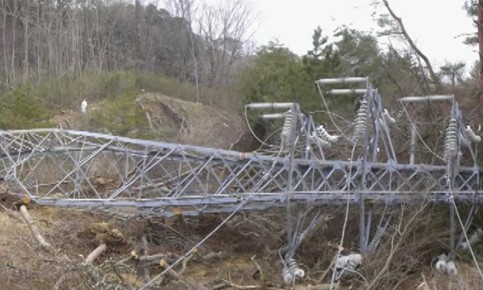Tepco’s video tour of Fukushima Daiichi nuclear power plant, Sept. 2013 (At 1:00 in) – The power line tower of units 5 & 6 fell over due to a collapse of the embankment. Consequently, the whole site lost its outside power source. 20-minute video here
WERU’s News Report interviews Dean Wilkie, nuclear reactor operations at a U.S. Department of Energy test reactor in Idaho (At 28:50 in) – When the accident happened back in March 2011 there was a power pole, one of these huge power poles, inside of the Daiichi facility, inside the area there, and the ground that it was set on became super-saturated with water and they had a mud slide and that whole tower went down […] At Fukushima now, what we’re seeing, all of this work that they’ve been doing with these walls and then it’s causing the water to back up, it’s starting to saturate soil that’s underneath the buildings and in adjacent areas around the buildings. Couple that with the fact that there are known fractures in that soil — it was very obvious during the earthquake. Full broadcast here
Nuclear Expert Gordon Edwards interview on the Green Power Wellness Show (At 32:00 in) – The worry with Unit No. 4, even though there was no fuel in the core of the reactor, there’s a spent fuel pool very precariously perched up above 5 floors. If the plant were to collapse — which it’s been showing signs of doing — then that fuel would be all over the place and it would be impossible to cool. And that would be a real… you could get far greater emissions than we did initially. Full interview here
Related info:
And here is what … “you could get far greater emissions than we did initially” … really means:
– ‘The Greatest Threat Humanity Has Ever Faced’: Fukushima Reactor No. 4 SFP ‘An Immediate Problem’ – Building Is Sinking, Over 30 Inches In Places:
The leakage of water from these cores is bad enough but the most dangerous thing is the cooling pool of unit 4. Now it is terribly dangerous because the entire hot core of reactor 4 had been removed and put in this cooling pool shortly before the tsunami. So, there was a hot core in this cooling pool the entire superstructure building was blown off in a hydrogen explosion.
The entire area is weakened and there is a great risk of an aftershock. Now this pool contains something on the order of 400.000 kg of hot plutonium. So, the thing that people should be aware of is that TEPCO is going to begin attempting to remove these rods from this pool to some other type of storage. This has never been done with plutonium rods that have been out of a core for such a short period of time.
There is a great danger of a thermonuclear reaction if these rods become exposed to the air and the cooling pool itself is just barely containing the temperature levels of the core as it is.
…
The media coverage of the situation has been almost non-existent. The public must become engaged and the governments must become engaged because this is a global threat. They say that one microgram of plutonium could theoretically kill a person.
There are billion micrograms in a kilogram and there are 400.000 hot kilograms in this pool. So, if these rods combust, if the set of rods begins a thermonuclear reaction, it will vaporize the water in the pool and the entire pool can become an uncontrolled nuclear reaction open to the air. These particles will be spread through the northern hemisphere.
This is perhaps the greatest threat humanity has ever faced. And I think you would acknowledge there has been far too little attention given to this at this point and the measures that the Japanese government is discussing at this point are not sufficient, I believe. Other governments must become engaged in this.
A collapse of Fukushima reactor no. 4 SFP would mean the end of humanity as we know it.

Why this isn’t on the front page of every news outlet is beyond me. We may well be looking into the face of our own destruction. Thanks again for staying on this important story.
Not that I even believe that we should have nuclear energy, but why in the very beginning was there not a call for the world’s greatest nuclear scientists to come to the area to wrap their collective brain power around the challenges of Fukushima.
The world is certainly looking down the barrel of a nuclear gun and even our media barely skims the surface.